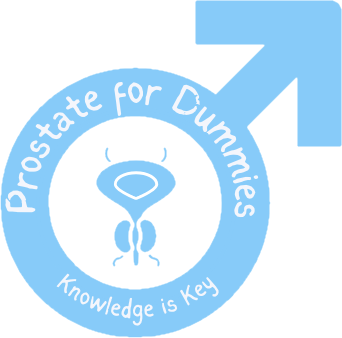Prostate Mania, what do I need to know? There has been a lot of hype recently about men’s prostate. All men have one, which may cause problems for us as we grow older. Here we begin the process of learning about our prostate. The Good the Bad and the Ugly.
The prostate gland plays a crucial role in male reproductive health, yet many men remain unaware of its anatomy and function. Located below the bladder, this walnut-sized organ produces seminal fluid and supports sperm health. Understanding the anatomy of your prostate is essential for maintaining overall well-being and detecting potential issues early.

As men age, the prostate becomes more susceptible to various conditions, including benign prostatic hyperplasia (BPH) and possibly prostate cancer. Knowing the structure of the prostate can help men recognize warning signs and seek timely medical attention. Regular check-ups and screenings become increasingly important as one gets older, helping to maintain prostate health and catch potential problems before they become serious.
Note: Prostate cancer is often one of the slowest-growing cancers out there, so much so that medical professionals may be content to leave it alone for a while (with careful monitoring), before attempting to fix it.
So a diagnosis of prostate cancer may not be a death sentence. It grows slowly and it is treatable in most cases.
Caring for the prostate is not just about preventing disease; it also impacts sexual function and overall quality of life. By learning about prostate anatomy and adopting healthy lifestyle habits, men can take proactive steps to maintain their reproductive health and well-being.
Key Takeaways
- The prostate gland is vital for male reproductive health and produces seminal fluid.
- Understanding prostate anatomy helps in the early detection of potential issues.
- Regular check-ups and a healthy lifestyle contribute to maintaining prostate health.
Understanding Prostate Anatomy and Function
The prostate gland plays a crucial role in male reproductive and urinary health. Its unique structure and location enable it to perform essential functions in both systems.
Structure of the Prostate Gland
The prostate is a walnut-shaped organ located below the bladder and surrounding the urethra. It typically weighs about 20-30 grams in adult men.
The gland consists of three main zones:

- Central zone
- Peripheral zone
- Transition zone
- Fibromuscular zone
The 3 main central, peripheral, and transitional zones contain glandular tissue responsible for producing prostatic fluid.
The prostate’s size can increase with age, potentially leading to urinary issues.
Blood vessels and nerves vital for urinary and sexual function surround the prostate. This complex anatomy makes prostate conditions challenging to treat without affecting nearby structures.
The Prostate’s Role in Urinary and Reproductive Systems
The prostate serves dual functions in the male body. In the urinary system, it helps control urine flow by surrounding the urethra. The gland can contract or relax, influencing urination.
For reproduction, the prostate produces a fluid that makes up 20-30% of semen volume. This prostatic fluid contains enzymes, zinc, and other components that nourish and protect sperm.
During ejaculation, the prostate contracts to expel this fluid into the urethra, where it mixes with sperm from the testicles. This process is crucial for male fertility and sexual function.
The prostate’s position and functions make it susceptible to various conditions, including benign prostatic hyperplasia (BPH) and prostate cancer. Regular check-ups can help monitor prostate health and detect issues early.
Do I need to worry about my prostate?

The short answer is no, not really. While your prostate may give you problems as you age, it also may not give you any problems at all.
What is important is to educate yourself about your prostate and understand how and what you can do to maintain a healthy prostate.
Any Questions at all – See your Doctor
Medical professionals are the best source of information for prostate health concerns. Regular check-ups are crucial, especially for men over 50 or those with a family history of prostate issues. Doctors can provide personalized advice based on individual risk factors and symptoms.
Urologists specialize in prostate health and can offer expert guidance. They can perform necessary exams and tests to assess prostate function and detect any abnormalities.
Don’t hesitate to discuss symptoms, concerns, or questions with a healthcare provider. Early detection and treatment of prostate problems can significantly improve outcomes.
Common Signs of Prostate Issues
Recognizing potential prostate problems is crucial for timely intervention. Common symptoms include:
- Frequent urination, especially at night – Nocturia
- Difficulty starting or stopping urination
- Weak urine stream
- Incomplete bladder emptying
- Pain or burning during urination
- Blood in urine or semen
- Pain in the lower back, hips, or pelvic area
These symptoms can indicate various conditions such as benign prostatic hyperplasia (BPH), prostatitis, or prostate cancer. BPH, an enlarged prostate, is common in older men and can cause urinary symptoms. Prostatitis, an inflammation of the prostate, can cause pain and discomfort.
Diagnostic Tests and Procedures
Several tests can help diagnose prostate issues:
- PSA Test: Measures prostate-specific antigen levels in the blood.
- PHI Test: Prostate Health Index – a more comprehensive PSA test
- Digital Rectal Exam (DRE): Physical examination to check prostate size and texture.
- Prostate Biopsy: Samples prostate tissue for cancer detection.
- Urinalysis: Checks for urinary tract infections or other issues.
- Cystoscopy: Examines the urethra and bladder using a thin, lighted tube.
Imaging tests like ultrasounds or MRIs may be used to visualize the prostate and surrounding structures. These diagnostic tools help healthcare providers determine the best course of action for prostate health concerns.
Things to try to maintain a Healthy Prostate
If you have or suspect you have prostate problems – please seek out medical advice.
However, if you just want to improve your prostate health consider implementing these things:
- Maintain a healthy diet rich in fruits, vegetables, and whole grains.
- Exercise regularly to promote overall health and manage weight.
- Stay hydrated by drinking plenty of water.
- Limit alcohol and caffeine consumption.
- Practice pelvic floor exercises to strengthen muscles.
These measures can help alleviate mild symptoms and promote prostate health. However, they should not replace professional medical advice or treatment for significant concerns.
Certain supplements like saw palmetto or beta-sitosterol may provide relief for some men, but their effectiveness varies. Always consult a healthcare provider before starting any new supplement regimen.
Frequently Asked Questions

The prostate gland plays a crucial role in male reproductive health and urinary function. Understanding its anatomy, functions, and potential issues can help men take proactive steps to maintain their well-being.
What are the three primary functions of the prostate gland?
The prostate gland has three main functions:
- First, it produces a fluid that nourishes and protects sperm cells. This fluid makes up about 30% of semen volume.
- Secondly, the prostate secretes an enzyme called prostate-specific antigen (PSA), which helps liquefy semen after ejaculation.
- Thirdly, the prostate gland assists in controlling urine flow and ejaculation through its muscular action.
How does the prostate gland affect a man’s health?
The prostate gland can significantly impact a man’s overall health. It plays a vital role in reproductive function and urinary control.
Prostate problems can lead to urinary issues, sexual dysfunction, and in some cases, prostate cancer. Regular check-ups and screenings are essential for early detection and treatment of potential issues.
Where exactly is the prostate gland situated in the body?
The prostate gland is located in the male pelvis, just below the bladder. It surrounds the urethra, the tube that carries urine from the bladder out of the body.
The prostate sits in front of the rectum, which is why digital rectal exams are used to assess its size and texture.
What are some common symptoms indicating a potential prostate problem?
Common symptoms of prostate issues include frequent urination, especially at night. Difficulty starting or stopping urination may also occur.
Other signs include weak urine flow, pain or burning during urination, and blood in the urine or semen. Erectile dysfunction and pain in the lower back, hips, or thighs can also indicate prostate problems.
What natural methods are recommended for reducing prostate enlargement?
Several natural methods may help reduce prostate enlargement. A diet rich in fruits, vegetables, and whole grains can be beneficial.
Regular exercise, particularly aerobic and resistance training, may help maintain prostate health. Limiting alcohol consumption and staying hydrated are also recommended.
Certain supplements like saw palmetto and beta-sitosterol have shown potential benefits, but their effectiveness varies. It’s important to consult a healthcare provider before starting any new treatment regimen.
Should I be worried about my prostate?
Not really. Everyman has a prostate. Not every prostate has problems, though as you grow older you should be aware and get your prostate checked regularly, especially after 50.
If you do not experience any of the symptoms listed above here, you most likely have no issues. However, if you are over 50, you need to have a PSA test to start the process.

